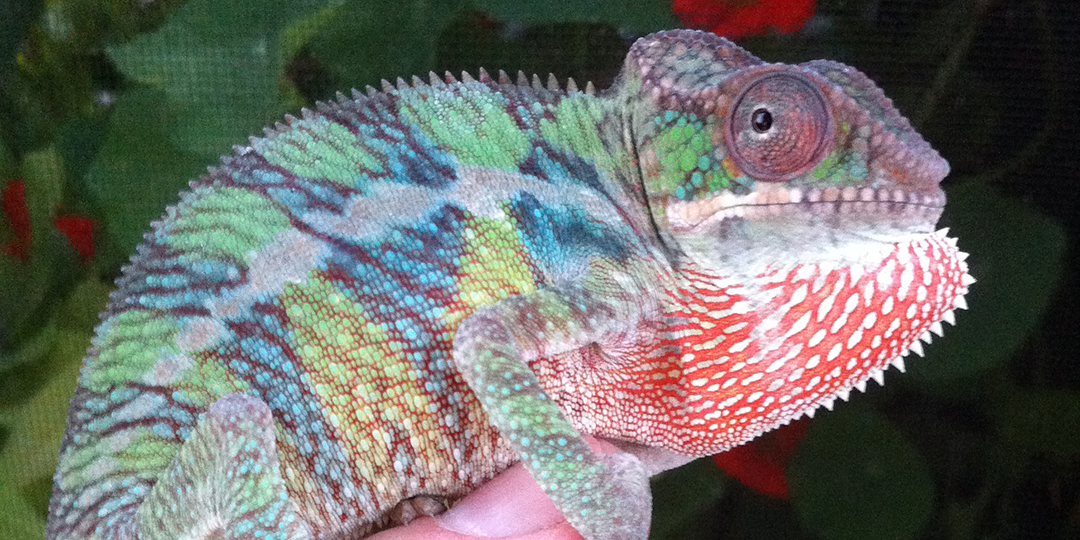Ep 208: Chameleon Caresheet Confusion
Listen Here!
What do you do when the chameleon experts contradict each other? You just want to set up your chameleon right the first time. Why can’t anyone agree on how to do it? In this episode I talk about how to reconcile different experts saying different things.
Link Resources
The following links were mentioned on today’s podcast:
Vitamin A Antagonizes the Action of Vitamin D in Rats
Ep 126: Supplementation at Kammerflage Kreations (learn why cohabitation doesn’t work!)
Chameleon Academy YouTube Channel
Transcript (more or less)
Introduction
As many of you know, I just released a video component to the Chameleon Academy Panther Chameleon care summary. If you go to the Panther Chameleon page on the chameleonacademy.com website you will find a .pdf download of the care summary. You’ll find this care summary much different from standard care sheets as this one contains a level more information such as information on the cage interior, the lighting/hydration cycle, feeding quantity, and not only what level of UVB, but distance to the light fixture if you use a certain product. Backing that up is a webpage that explains every parameter on the care summary so you can understand it better. My vision for the Chameleon Academy has been that it would be a multi-media chameleon education experience so there is also a video companion tutorial and a podcast episode for researching on the go. So with this wealth of information you are confidently set to get your panther chameleon! Until, that is, you compare what I say to what your social media group says. And it doesn’t match up. And then your friend gave you a care sheet from the expert they say is 2nd to God in knowledge…and that contradicts both me and your social media group. So you pull up the care page on the website of the breeder from whom you have purchased a juvenile that will be ready in one short month! How can there be so many different opinions….no, not just opinions….deeply embraced convictions on the care parameters of one of the most commonly kept chameleons?
That is what I will discuss today. Even if you decide that you trust my information and want to go with it, we are a community and so you will have to deal with all these various view points when interacting. I am going to highlight the top six debate points you will find during your research into chameleon husbandry and your use of the care summary I just released. I will share the history behind them and the concern level.
Caging
First we have caging. There is nothing that controversial with my caging parameters. I do recommend larger cages for females. Many care sheets have males at the 2x2x4’ cage and the females at the 18x18x36”. My care summary has them both at 2x2x4. Your female chameleon will appreciate the larger 2x2x4 cage usually recommended for males. But, if you set the cage up correctly, the often recommended 18x18x36 will work. Keep in mind, though, that these are all minimum sizes. No breeder will say you shouldn’t get a larger cage so even though what I say is a little different it won’t be controversial. You may run into the random social media expert that read a care sheet and didn’t understand the concept of “minimum”, but, by and large, going bigger is not going to raise any eye brows.
The point where there may be some confusion to work through is that I promote that cage type should be chosen with respect to your ambient room temperature. The closer your temperatures and humidity levels are to ideal the more screen panels. The further they are from what you are trying to provide your panther chameleon, the more solid sides. Because the average household has acceptable temperatures, but the panther needs higher humidity at night than most houses provide, I lean towards hybrid cages with mostly solid sides as my most common recommendation.
So, what do you when your breeder says that chameleons need a screen cage or else they’ll get a respiratory infection and die?
Well, here is another case where you have to choose who to listen to. And then stick with that information source.
Let me explain. There are many ways to get something done. Yes, some ways are better than others, but there are times when different ways can still get the job done even if some of those are better than others. And you have to pick what you are going to make work.
With the Chameleon Academy I am promoting a thoughtful and insightful approach to chameleon husbandry. Much of the husbandry I talk about is a bit more complicated than your standard husbandry advice. It requires more thought. It isn’t necessarily hard, but it does take some understanding. And, I don’t think it is unreasonable to expect that learning chameleon husbandry might take some thought and learning.
A hybrid cage will retain heat and humidity. That is the reason for getting a hybrid cage, of course! But it also means that you are able to over do it. So it requires you to develop the discipline to watch your heat and humidity levels. Well, mostly the heat. In a screen cage most people will struggle to get anywhere near the target humidity levels, but it will be hard to overheat or over-humidify the cage. Because you are literally using your small heat bulb and humidifier to change the entire room environment. So you get a localized heat or fog cone with it quickly dissipating. And, so it is harder to over do anything. People have adjusted their care to account for screen cages. And this is one reason why you can’t pick and choose care parameters from different places. Someone telling you to use a screen cage will often also be telling you to mist regularly through the day. This is because your chameleon will need to drink during the day to make up for losing moisture during the night because the humidity was low. And this is how we all did it for many, many years. So, yes, it works! But do you see how one parameter was adjusted to make up for a deficiency in another? So, take some time and get comfortable with your information source and don’t be rattled when you run into five other perspectives saying they are the only one. And I will take the unorthodox approach and say between me and your breeder, listen to your breeder. Your breeder is the one that is meant to be there to hand hold you through the process. That is what they are there for. Pass on that only if you have a community or mentor that is willing to take the role of guiding you. And then don’t go back to your breeder and make them unravel everything you have done outside their care parameters. Every group has figured out how to make their method work and they may or may not be able to switch gears in their head. And this isn’t what you want in the first place. You want the person guiding you to come from their place of strength and that would be their method that they have perfected. So, back to cage type, if you are having trouble getting the humidity up with the screen cage your breeder told you to get then have the breeder help you figure out how to get the humidity higher. Though, yes, my care summary has been put together using decades of personal experience and incorporating input from around the world so, if I have done my job right, you will be able to study what I have written and understand it enough to make an educated decision on your own. But remember, this is one of those topics that people take personally. Most people in the community have heard of hybrids and glass and write them off as advanced caging. Some outright say anything but a screen cage will kill you chameleons. So there is a lot of drama surrounding this topic. And if you say you are using a hybrid cage to a person who only knows screen cages get ready for an uncomfortable exchange. It is like putting a Mac computer in front of a person who has used a PC all their life. Some will stumble through it and figure out how to get on the internet and some will just pull out the holy water and wood stake.
Basking Temperature and Length
There is a shift going on in the chameleon community which is touching panther chameleon care. We, and I mean we as in the general community are becoming more aware that hotter conditions, combined with high food intake is not healthy for chameleons. This, I think, takes a little history. As we grew up in our chameleon keeping we were desperate to keep them alive. This is in the 1990s. It was exciting to have chameleons live years. Then we went to the next stage of herpetocultural growth and wanted to be able to breed them. This happened quite easily with panther chameleons. So during this time we would be babying them and providing anything that would make them grow quick and large. This was, and still is, a common benchmark. Big is healthy, right? If you saw two panther chameleons and one was twice as big, that is the one you would want. Well, yes, and, back in the early days that would be a very accurate assessment! But now that we have gotten way past the stage of keeping them alive and being gitty that we successfully bred them we are turning our attention to refining their health. And we are finding that bigger is not healthy. Sure size is fine, but bulging fat pads are not. This is demonstrated most dramatically in Veiled Chameleons where over-energizing the females with heat and food makes their bodies overproduce eggs to a life threatening number. You have probably heard of egg binding. A common cause for death from egg binding is females whose fat pads have swelled and egg production is two to four times what it should be. The females become marble bags and have complications. This comes from over energizing the females body through heat and food. Although the condition is not as severe in panthers as it is in veileds, there is still that danger of over-engerizing the panther females. And so you will see care sheets run a wide range of basking temperatures from 100 degree F to 80 F. The higher the temperature the older the care information. This is a husbandry area we are still working on figuring out the right recipe of temperature versus food intake. I have chosen 85F to 90F because it is on the lower side and is well tested. In the coming annual updates I am sure that I will lower the basking temperatures, but I can’t until I know what is safe. You see, lowering temperatures and food intake too far will produced stunted chameleons. And I need to know where that border is before my care information gets closer to it. I am actively doing extensive work with panther chameleon care parameters so as soon as I am confident I have a regimen that is as simple as possible without getting people too close to the edge I will adjust parameters. But for now, just be aware that there is a shift going on in the community and you will see various basking temperatures. 85-90 is a good safety.
You will also see talk about time that your basking bulb is left on. Reducing the time the basking bulb is on is a strategy employed by some sections of the community to prevent the over energizing of the female. I have been experimenting with basking temperature and lengths. So far, I have found slower growth, but no stunting yet. So there is promise that this is a tactic that can be used. I am not to the point where I think I can recommend this without beginners mis-stepping and having problems so I am still conservative on this tactic. You see, I am not only responsible for the information I provide, but how it is interpreted and executed by the readers. So I am careful how I present new methods. At this time, I advocate leaving the basking bulb on as long as your chameleon needs it. As I said in the care summary, this takes observing your chameleons behavior. In a hybrid cage you’ll probably have to turn it off after a morning warm-up. In an all-screen cage you probably can leave it on all day. But this is a parameter I really want you all to be mindful of. Watch your chameleon. Learn what they use and realize you can turn on and off the basking light as is appropriate for your conditions.
Humidity and Naturalistic Hydration.
Another shift in our community is the increased awareness of how humidity plays into our hydration husbandry. Most care sheets do not recognize nighttime humidity needs. This is where we follow the natural cycle of higher humidity, lower temperatures during the night and lower humidity/higher temperatures during the day. I have called this the naturalistic hydration cycle and this is the prime example of how all care parameters are interlinked. The standard hydration method has been using a screen cage and misting multiple times during the day. This is what you will see from many breeders and social media groups. Since the humidity is standard low human house levels the chameleon loses moisture during the night breathing. This requires misting during the day to rehydrate.
In the naturalistic hydration method we provide high humidity during the night and mist so the chameleon can drink during the morning if he needs to. And this provides what they need so we don’t have to spray them during the day which they hate.
But to do this the fundamental core of our husbandry has to change. To raise the humidity we need to block off the ventilation to the point where we get enough airflow for air exchange and cage drying during the day. That allows our nighttime humidity to build up. And this requires a hybrid cage with solid sides. Then we can create a nice build-up of humidity at night. But a hybrid cage also holds in heat during the day so we now have to be mindful of heat build up from the basking bulb. This means we have to introduce the concept of reducing basking bulb on time and monitoring temperatures. That seems simple in concept, but going on social media you learn that this is for advanced keepers only. So there is a slow shift in understanding towards the naturalistic hydration. It is resisted by many, and not fully understood by others, so be aware that there will be a wide swing of opinions around humidity and when you should mist. Really, the best thing you can do for yourself is understand the different methods and make the decision for yourself. But, if you are still confused then go with the method advised by the person helping you along. Once again, I fully admit that the Chameleon Academy approach can be intimidating at first. I can say I have personally tested the naturalistic hydration over a number of years with many species and it is a better approach than the screen cage/daytime misting approach. I highly encourage you to use it. The naturalistic hydration method should be your end goal, and start here if you can, but it is something you can incorporate later if you wish.
Supplementation
Next, Supplementation. This is where we add mineral and vitamin powders dusted on the surface of our feeder insect and we add nutrition in this manner. The reason why there is a wide range of supplementation regimens is that we are still figuring out supplementation. We have a fairly good idea of what works, but we are quite primitive as far as understanding how much of what, and in what combination, is needed. And that gray area leads to a wide range of personal interpretations. This means that you are going to be exposed to the supplementation regime your information source tried and their chameleon didn’t get sick. That is the level of certainty we have right now.
The main area of debate is how much vitamin D3 to allow through the diet. In nature, chameleons get their Vitamin D3 from UVB just like we do. The sun’s light hits our skin and we use the UVB wavelengths to synthesize vitamin D3. Vitamin D3 is critical because that is what lets us absorb calcium from what we eat. Without Vitamin D3 we don’t get calcium and without calcium our bones get soft and will break. It is called Ricketts in humans and Metabolic Bone disease in chameleons. So we need vitamin D3. For the longest time, both education about UVB and UVB bulb strength was lacking and so we had many horrible cases of Metabolic Bone Disease. This was solved by putting vitamin D3 into the supplements we put on our feeder insects. This was a wonderful solution except that there is a danger of D3 overdose because it is a fat soluble vitamin and excess amounts won’t just flush out of the system. There is a built in stop valve for D3 being generated from UVB, but no stop valve if it comes in from the diet. Therefore, if you give too much in the diet you could get hypercalcemia which means too much calcium in the body and life limiting things like calcium deposits on organs where they shouldn’t be. We want to avoid that. And with present UVB light technology we don’t have to use dietary vitamin D3. The one case where present information suggests we use dietary vitamin D3 is alongside giving preformed vitamin A. Honestly, I am still working through understanding how this works and how it applies to reptiles, but with nutrition that is a common state of affairs for us. Reptile nutrition is not the most funded area of science these days. I’ll link to an abstract about a study in rats where giving Vitamin A decreased the effectiveness of calcium absorption. So this is why more vitamin D is, most of the time, added to supplements with preformed vitamin A. But, that is leading us down a rat hole, so to speak. Back to different supplementation regimens.
You’ll run into two main varieties of routine. One is the one presented in the Chameleon Academy which is calcium and bee pollen based for every feeding and then a multivitamin with preformed vitamin A every two weeks. You will run into many variations on this approach. The philosophy behind the academy approach is that we give calcium and bee pollen every feeding and simulate a random vertebrate every two weeks that gives a shot of vitamin A. The chameleon gets vitamin D3 from UVB every day as well and, if this is done correctly, there is no need to have D3 in the diet. The D3 in with the biweekly multivitamin is just there to keep the vitamin A company.
The other regimen you will run into with a number of breeders is using Repashy Calcium Plus every feeding. This has worked well over time and has been adopted as a much easier to remember supplementation schedule. Different supplementation routines are like fighting words in the chameleon community so prepare for strong feelings when you bring it up. I have linked a podcast episode that goes into the testing done by Kammerflage Kreations for them to decide on the Repashy Calcium Plus regimen. It is a thoughtful and well tested decision. If you are considering this approach then listen to the episode to understand what was behind it. I find myself in the strange position of recommending a different supplementation regimen while defending the use of Repashy Calcium Plus. And the reason why it is important for me to defend using Repashy Calcium Plus every feeding is because the methodical approach that went into showing that this is effective should serve as a model for how we test any supplementation regimen. My defense of using Repashy Calcium Plus is not because that is the supplementation I want to recommend, but I am defending the method used to test it. If we put in that amount of work into any of the things the community presents as facts we would have a much stronger community less able to be swayed by the latest loud voice that comes along. I ask that you take this to heart. I see so many half baked ideas being passed around because there was no critical thought applied to its creation or adoption as a sound bite.
Maybe one day there will be some repeatable test that will determine what the danger level is for daily vitamin D3 intake. And then this issue will be laid to rest (well, maybe). But, my message to you, who are just trying to make heads or tails of this subject is that both regimens work. If you want to use your breeder for support then go with the supplementation and UVB regimen that they suggest. If you want to go to a certain social media group for support then use their regimen. Just know you can’t go back and forth. Don’t use the social media regimen and then go back to your breeder if something is off. Get support from the person who you get advice from. If you are following Chameleon Academy advice and want to ask questions then my experienced team and I have camped out at the Facebook group, The Chameleon Enthusiasts to offer support. At The Chameleon Enthusiasts group the team is dedicated to helping across all supplementation routines. We make it a point to understand what is behind the supplements so we can offer an insightful analysis no matter which regime you are using. Just about anywhere else, a different supplementation routine will be blamed for anything going wrong without a critical analysis. And this is, yet again, the reason why you need to use the method understood by the breeder, mentor, or group that you will be interacting with. Understanding supplementation is challenging. One thing I will warn you about is any supplementation regimen that uses calcium plus D3. Both Fluker’s and Rep-cal calciums with D3 are way over the top with D3 and if there is going to be a supplement that tips the scales into overdose, it will be them. If you are told to use either Flukers Calcium with D3 or Rep-Cal Calcium with D3 then it is time to take a step back and re-evaluate.
UVB lighting
Next is UVB lighting. The Chameleon Academy care summary uses the T5 HighOutput fluorescent lights. This is the most common bulb used on social media so there shouldn’t be much of note there. ,Use the UVB chart on the Chameleon Academy care summary. If your breeder recommends using a T8 light, using a T5 light will not change anything other than give you better D3 synthesis at a given distance. So using the Chameleon Academy UVB recommendation will not interfere with any other care parameter that you find out there. And it will ensure good D3 synthesis no matter what the supplementations schedule.
There may be some people that are concerned about using a T5 light system with a supplementation regimen such as Repashy Calcium Plus that has vitamin D3 in it. This comes from a lack of understanding of how UVB and D3 works. I’ll try to give a summary example. The body creates only the amount of D3 that the body needs. Say the chameleon needs 10 units of D3 a day. The body will turn on the UVB conversion and make 10 units of D3 and then shut down conversion. It does not matter how intense the UVB light is after that. It cannot turn back on the conversion. If you then give 8 units of dietary D3 through your supplement then the body will only make 2 units from UVB. And it doesn’t matter how intense the UVB is. What I am getting at is that is if you give Repashy Calcium Plus it doesn’t matter if you use T8 lights or T5 lights. You will not cause a D3 overdose from using T5 lights. Now, going too high will cause other problems, but not D3 overdose. And Dr. Gary Ferguson did a study showing that panther chameleons will deliberately bask as long as they needed to get the UVB they need. So, using a T5 as directed on this care summary is compatible with all appropriate supplementation schedules. This, of course, assumes a proper supplementation schedule as discussed above.
So, bottom line, use the Arcadia ProT5 6% UVB on top of a screen cage with the back of your chameleon 6” from the top. Please review the care summary for details and asterisks and such.
Feeding
And finally, there is a feeding schedule that has feeding chameleons as much as they will eat until they are adults and then easing off to five feeders every other day. This is another case where we are trying to avoid unhealthy weight. My five feeders every other day is less than most breeders recommend, but still more than some care sheets. This is the exact same case as with the basking temperature where I want to see more cases of how people execute this before I go lower. I have had people stop giving food to chameleons that were behind in growth because of a general schedule meant for chameleons on the standard growth cycle. So I have to be careful and sensitive to how this information is interpreted. Five feeders every other day is effective, yet conservative. But you will see a wide range of advice out there.
So I hope that this helps ease you into the community and understand all the different opinions out there. It would be simplest if there was one care sheet we all agreed on and presented. But that isn’t the case. And beginners like to come onto the scene, collect caresheets, and then pick and choose parameters. So there is no way to keep anyone focused on one path. And, that makes sense. When you are new to the community you do not know where the best information is. Instead of telling you to just listen to my one way, I would rather explain why things are the way they are, share the transitions we are going through as a community, and have you understand why you are going in a certain direction. It is okay for you to do something other than what I am advising. Just know the options and know why you have chosen a certain direction. Every situation will be different from different environmental conditions to different social involvement. And all these different parameters go into what is best for you. And the best thing you can do for yourself is to be able to understand the currents, and chose the appropriate captain, and chart your own course.
This podcast episode is certainly a stand alone episode that can explain the confusing twists and turns when looking for information in the chameleon community. But from the top view, it is the next step in my project to document the panther chameleon breeding lifecycle. I presented the panther chameleon care summary and this helps you navigate the community while reading the care parameters. We will now slowly get into caging with a mindset for breeding. Though you’ll find I am going to be presenting a somewhat different approach to this breeding group. And I hope it is one that will resonate and, perhaps, inspire a new generation of breeders.
I am slowly getting my stride in integrating my podcast with my video channel outreach. I have ambitious videos that take a bit of work and so I am going to try an every other week approach so one week a podcast episode and the next week a video and so on. I appreciate your patience as I work through this new outreach and figure out how I can humanly produce the content on a reasonable schedule! But, so far, I am very happy with how I am being able to fulfill the multi-media vision I have for the Chameleon Academy.
And, finally, if you go to the chameleonacademy.com website home page there is a link to where you can pick up some chameleon academy merch. From T-shirts to hoodies and a coffee cup. So you can sport the rainbow panther everywhere you go and share this very special corner of nature that endlessly fascinates us!
And if you think about it, everything we are learning about chameleons and the amazing depth to which we learn it, is a part of nature that few people know exists. This is truly an amazing personal growth we are all undertaking. And, just doing this is a growth experience for me. It is exciting to think where we will be by the end of the year. And, all I can say, is this is a whole lot of fun and I am glad you are doing it with me! Now, let’s see if I can get the video out next week and then I’ll be back here on the airwaves the week after! And, if you snag one of those T-shirts or hoodies, tag me on Facebook or Instagram wearing it and let me know if I can share it on my account!
Take care and give your chameleon an extra special treat for me. I’ll see you later!












